- Places
- Plans
- Itineraries
- Experiences
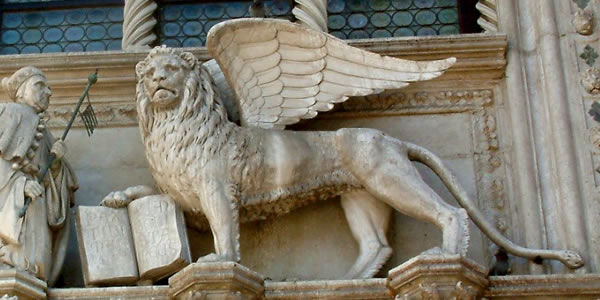
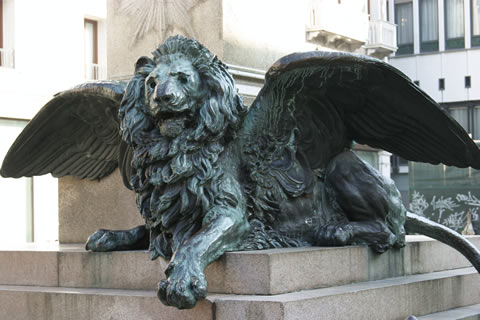
It is the city's symbol because this is the city of San Marco—Mark the Evangelist—and the lion was St. Mark's symbol.
Venice is the city of St. Mark because, well, because Venice stole him.
In 828 a group of Venetian merchants were visiting Alexandria.
In Alexandria rested the bones of the famous and oh-so-holy St. Mark the Evangelist.
So, of course, the merchants decided to steal him.
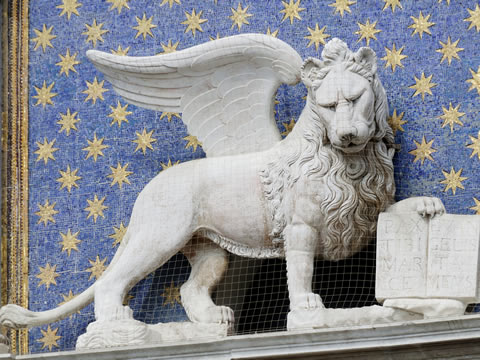 A Lion of St. Mark on the Torre dell'Orologio. (Photo © Marie-Lan Nguyen / Wikimedia Commons / CC-BY 2.5)
A Lion of St. Mark on the Torre dell'Orologio. (Photo © Marie-Lan Nguyen / Wikimedia Commons / CC-BY 2.5)Most folks settled for the finger bone of St. Elias, or the shriveled skull of St. Catherine, or a fragment of the ulna of St. Luke.
The Venetians figured: what would be better to carry home in patriotic triumph than a bit of St. Mark?
How about: Carrying home all of St. Mark.
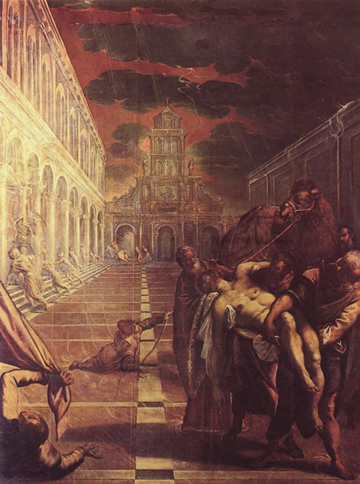 The Stealing of the Body of St. Mark by Jacopo Tintoretto (1562–66). (Image courtesy of the Yorck Project.)
The Stealing of the Body of St. Mark by Jacopo Tintoretto (1562–66). (Image courtesy of the Yorck Project.)The merchants returned home with their prize, and the city promptly set about building an appropriately extravagant church to house the holy remains.
The result: St. Mark's Basilica, and the adoption of Mark's iconic winged lion as the new symbol of the city. (Fun aside: Learn why the Evangelists—Matthew, Mark, Luke, and John—are symbolized by a man, a lion, an ox, and an eagle, respectively.)
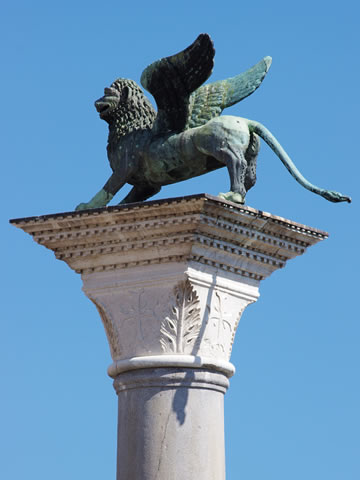
The audacity of the Venetians kick started something of a grisly competition between Italy's hyper-competitive maritime capitals to see who could steal the best saint then build a cathedral around his bones.
In 1087 Bari, in Apulia, countered by nicking the 4th century Turkish bishop St. Nicola di Myra, a.k.a. St. Nicholas, a.k.a. Santa Claus.
In 1206, Amalfi (which was much larger at the time, and a marittime power to rival Venice) entered the fray by taking home the bones of St. Andrew after the Sack of Constantinople.
In the interests of rounding off the subject:
The relics of St. Matthew are in the cathedral of Salerno, south of Naples on the Campania coast.
Most of St. Luke is now just down the road in Padova—except his head, which is in Prague.
(Fun aside: According to Orthodox tradition, Luke himself was a relic hunter! On a pilgrimage to Samaria, he supposedly brought the arm of St. John the Baptist back to Antioch with him.)
St. John is... tricky.
As with most early saints, there is much scholarly debate on just who St. John was—there were a lot of "Johns," some of whom may or may not have been the same guy.
However, the traditional story goes that John was the only Apostle not to be martyred, and that he lived to a ripe old age preaching to his own followers in Ephesus, where he died and which retains his tomb... but not his bones.
When his (said-to-be-miraculous) tomb under the (now-destroyed) basilica named for him was opened in the 4th century, it was found to be empty. Was it a victim of the earliest of church relic hunters?
True believers have their own story: that John had been informed by Jesus himself in a vision of the day when he would die, and that he entered a cave in his little hillside church whereupon vanished in a flash of light, assumed bodily into Heaven.
Sound far-fetched? Perhaps. But the fact remains that, even with tens of thousands of saintly bones nestled in gilded chruch reliquaries around the world, St. John remains the only major saint to have no church anywhere on earth claiming a holy relic in his name.
Share this page
Search ReidsItaly.com